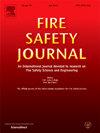铸造 PMMA 棒材在并行轴向滞流中的部分重力可燃性
IF 3.3
3区 工程技术
Q2 ENGINEERING, CIVIL
引用次数: 0
摘要
测试是在零重力研究设施中的部分重力离心下落车中进行的,在轴向浮力停滞流中使用浇铸的 PMMA 棒,以确定可燃性极限与部分重力水平的函数关系。在平均 57.6 千帕(8.4 PSIA)的环境压力下,研究的部分重力水平从 0.04 克到模拟的 1 克不等,环境氧气浓度按体积计算从 13.2% 到 15.2% O2,这与预期的月球栖息地压力非常接近。在五个重力水平下,确定了 PMMA 的可燃性边界与氧气浓度和重力水平的函数关系。在火焰趋于稳定的停滞区,科里奥利效应似乎微乎其微,而在重力水平较高时,火焰尖端确实会出现一些弯曲。月球重力水平接近氧气-重力水平可燃性边界的最小值。这表明,火灾是未来月球探测任务的一个重大安全风险,因为在正常重力下对材料进行筛选,以评估其在太空中的安全使用。如果正常重力筛选并不保守,则需要采用材料降额法,以确保材料在月球上不易燃。由于吹脱边界似乎与强制流速度呈线性关系,因此有可能进行高强度强制流吹脱测试,然后将其向下推断到有效的月球重力水平,以提供 1g 与月球可燃性限制之间的氧三角洲,从而降低材料的可燃性。本文章由计算机程序翻译,如有差异,请以英文原文为准。
Partial gravity flammability of cast PMMA rods in concurrent axial stagnation flow
Testing was performed in a partial gravity centrifuge drop vehicle in the Zero Gravity Research Facility with cast PMMA rods in concurrent axial buoyant stagnation flow to determine flammability limits as a function of partial gravity level. The partial gravity levels studied varied from 0.04 g to a simulated 1g for ambient oxygen concentrations from 13.2 % to 15.2 % O2 by volume at an average 57.6 kPa (8.4 PSIA) ambient pressure, which is very close to the anticipated Lunar habitat pressure. The PMMA flammability boundary as a function of oxygen concentration and gravity level has been determined at five gravity levels. Coriolis effects appear to be minimal in the stagnation region where the flame is stabilized while the tips of the flame do show some bending at the higher gravity levels. Lunar gravity levels are near the minimum in the oxygen - gravity level flammability boundary. This suggests that fire is a significant safety risk for future exploration missions to the Moon since materials are screened in normal gravity to evaluate their safe use in space. If normal gravity screening is not conservative, a material derating method will need to be applied to ensure the material is not flammable on the Moon. Since the blowoff boundary appears to be linear with forced flow velocity, it may be possible to conduct elevated forced flow blowoff testing that could then be extrapolated down to effective Lunar gravity levels to provide an oxygen delta between 1g and Lunar flammability limits to derate the material.
求助全文
通过发布文献求助,成功后即可免费获取论文全文。
去求助
来源期刊

Fire Safety Journal
工程技术-材料科学:综合
CiteScore
5.70
自引率
9.70%
发文量
153
审稿时长
60 days
期刊介绍:
Fire Safety Journal is the leading publication dealing with all aspects of fire safety engineering. Its scope is purposefully wide, as it is deemed important to encourage papers from all sources within this multidisciplinary subject, thus providing a forum for its further development as a distinct engineering discipline. This is an essential step towards gaining a status equal to that enjoyed by the other engineering disciplines.
 求助内容:
求助内容: 应助结果提醒方式:
应助结果提醒方式:


